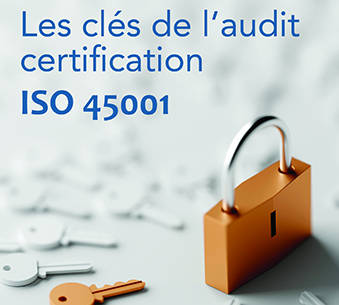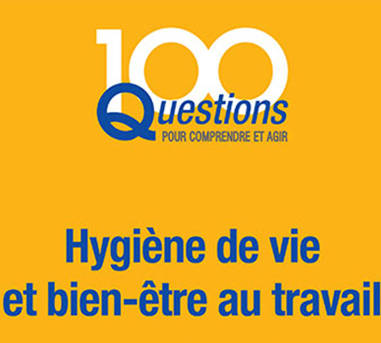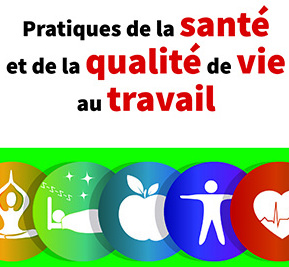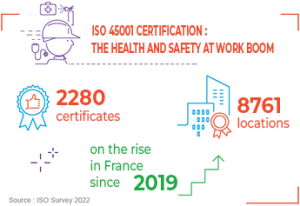
The International Labour Organization (ILO) estimates that, worldwide, more than 2.3 million people lose their lives every year as a result of work-related accidents and illnesses. According to the ILO, the human cost of poor occupational health and safety practices represents 4% of gross domestic product every year. That’s why health and safety in the workplace is a fundamental concern for management.
If you’re about to embark on an S&ST initiative, don’t start from scratch! Voluntary standards are there to save you time: they provide you with proven approaches, developed by experts in the field, in a collegial and shared manner. These are the most legitimate and consensual approaches.
ISO 45001: the world’s benchmark definition of occupational health and safety
Like the tried-and-tested models for quality management (ISO 9001) and environmental management (ISO 14001), occupational health & safety (OH&S) also has its own voluntary international standard: ISO 45001. It replaces national S&ST standards such as OHSAS 18001, respects regulations and is compatible with ILO principles.
It provides a framework for managing risks and improving company performance in terms of safeguarding employees’ physical, psychological and mental health, promoting the elimination of injuries and pathologies and, overall, providing safe and healthy workplaces.
ISO 45001 is just as suitable for VSEs, SMEs, ETIs and major groups as it is for public bodies and professional federations. ISO 45001 is designed to be applicable to all organizations, whatever their size, product or service, or sector of activity. The proof: those who have gone so far as to be certified present a very diverse profile, like the Moroccan pharmaceutical laboratory Afric-Phar or electronic components manufacturer Axon Cable .
Develop a culture of prevention in line with ISO 45001 requirements
By not being prescriptive, ISO 45001 gives organizations the freedom to define how to implement an effective occupational health and safety approach. The standard does not require any means.
Its aim is twofold: firstly, to identify the internal and external contextual factors that could have an impact on its Safety objectives. Next, identify the relevant stakeholders, i.e. the players on whom the successful completion of activities depends. Forcing yourself to ask these kinds of questions raises awareness and anticipates the major issues that will have – or could have – an impact on expected results. Priorities are defined from the outset, to feed into policy and objectives, in line with corporate strategy.
Why get ISO 45001 certification?
1 – Know how to analyze risks , so as to be able to identify situations likely to represent a danger to workers, before a dramatic event occurs. As such, the standard calls for a proactive approach and the adoption of appropriate measures to protect both workers (MSDs, RPS, occupational illnesses, etc.) and the company.
2 – Reduce the number of accidents and associated costs: the company will see a reduction in the number of accidents in the workplace, as well as a reduction in the direct costs (occupational injury contributions) and indirect costs (loss of production, replacement, material repairs, legal proceedings, damage to brand image) borne by the company.
3 – Raising collective awareness: ISO 45001 provides the basis for a participatory approach, requiring management to work with all employees to improve working conditions, make workplaces safer and reduce risks.
4 – Adopt a simplified approach: No more compulsory procedures and records, it’s now up to teams to determine their own operating resources and tools, adapted to their needs. For companies already ISO 9001 and/or 14001 certified, the implementation of an integrated QSE management system will be all the easier.
5 – Improve your brand image and preserve your reputation: Reducing the number of tragedies and improving working conditions contributes to a better quality of life at work, and therefore to a better employer brand image. Better risk management also reduces absenteeism, staff turnover and production disruptions, and thus boosts customer confidence.
How to prepare?
What if you already went through ISO 45001 version 2018 training to gain expertise?
We’ll work with you to identify the course best suited to your needs. Whether your focus is solely on health and safety or on an integrated system, our training courses and skills assessments will help you bring your organization up to date with best practice.
You don’t have the time, or the subject is too complex for your teams?
Call on AFNOR BAO to find an ISO 45001 expert from among our 1,000 operational experts, from freelancers to multidisciplinary teams. Depending on your needs, he can carry out a diagnosis, a risk analysis, an internal audit, draw up a roadmap with you…
Do you need to test your approach before embarking on an external ISO 45001 audit?
- Online, with OKpilot , assess your compliance with ISO 45001, presented in the form of a checklist. You evaluate your management system, share your results internally and implement action plans to achieve compliance.
- On-site, you can request a blank, partial or complete audit. The assessment visit provides you with a complete diagnosis of your situation with regard to each of the ISO 45001 requirements.
See our video “Health and safety at work: the importance of training”.
See the video transcript
Hello, the impact of poor health and safety practices in the workplace
is disastrous, not only in human terms, but also financially.
That’s why health and safety in the workplace is such an important concern.
of most companies. The new ISO 45001 standard, an occupational health and safety management system, completes the range of products available on the market. quality and the environment in a QSE approach.
It provides a framework for improving worker safety, reducing workplace risks and
workplace and create safer and healthier conditions, even going so far as to
quality of life at work.
The voluntary ISO 45001 standard, which has become a must, follows the HLS structure common to
other standards, such as ISO 14001 or ISO 90001, and of course includes the
regulations. Whether you’re dealing with chemical or machine hazards, and whether you want to to create your single document or text zones, we have the solutions you need. for you.
See you soon in our training courses.
You may also be interested in …
- The VSE Pack: offer your employees or customers the comfort they deserve in their workplace!
- NF X35-800 standard on exoskeletons
- Other S&ST standards under development
- CObaz for all you need to know about current regulations
- Our selection of books on OHS :




